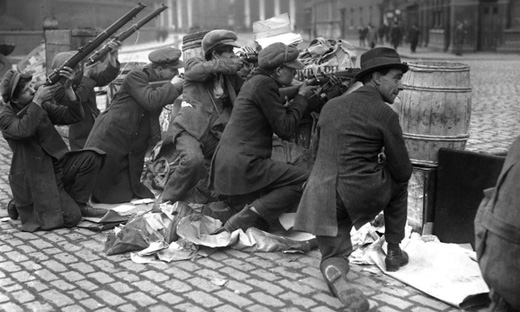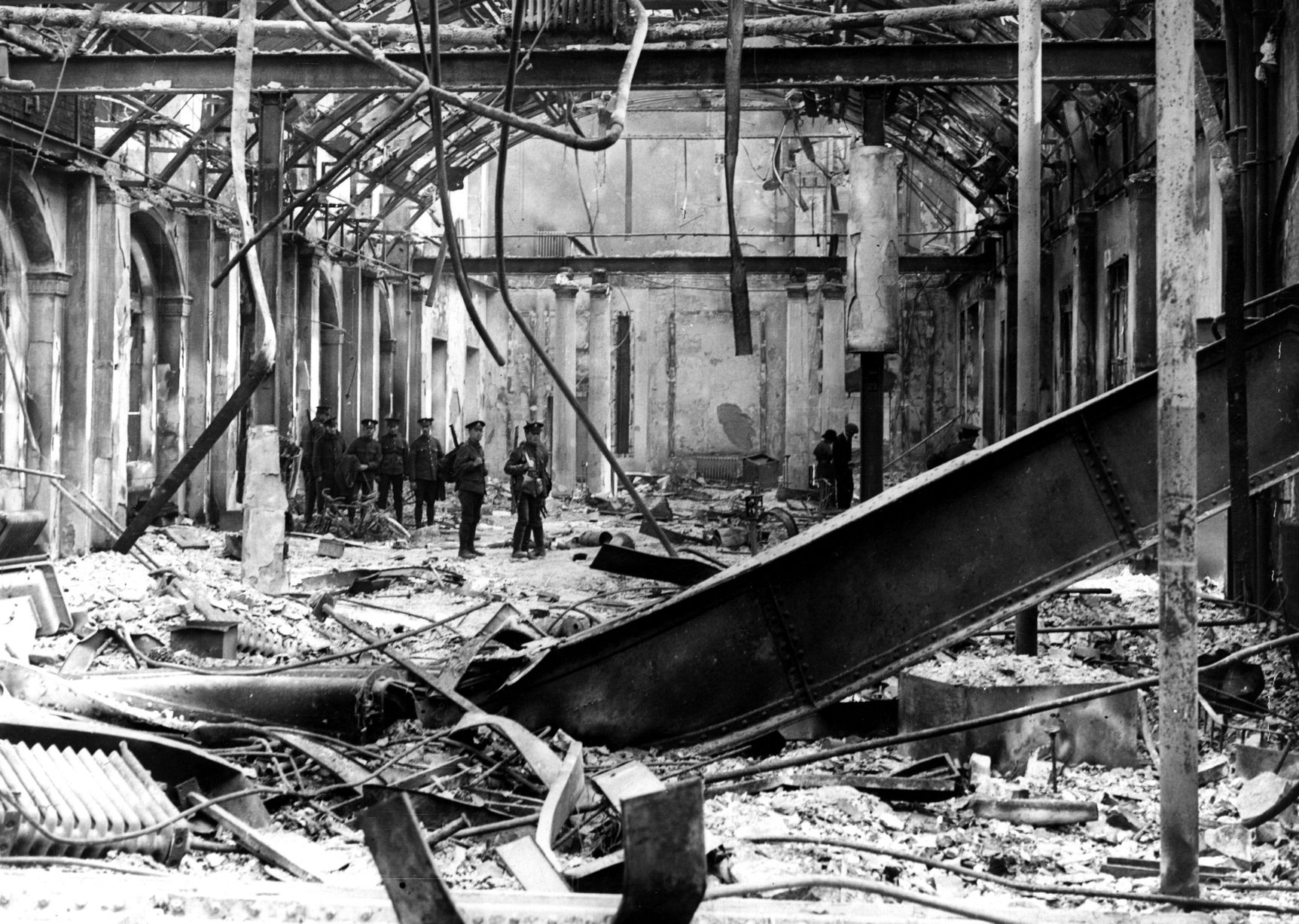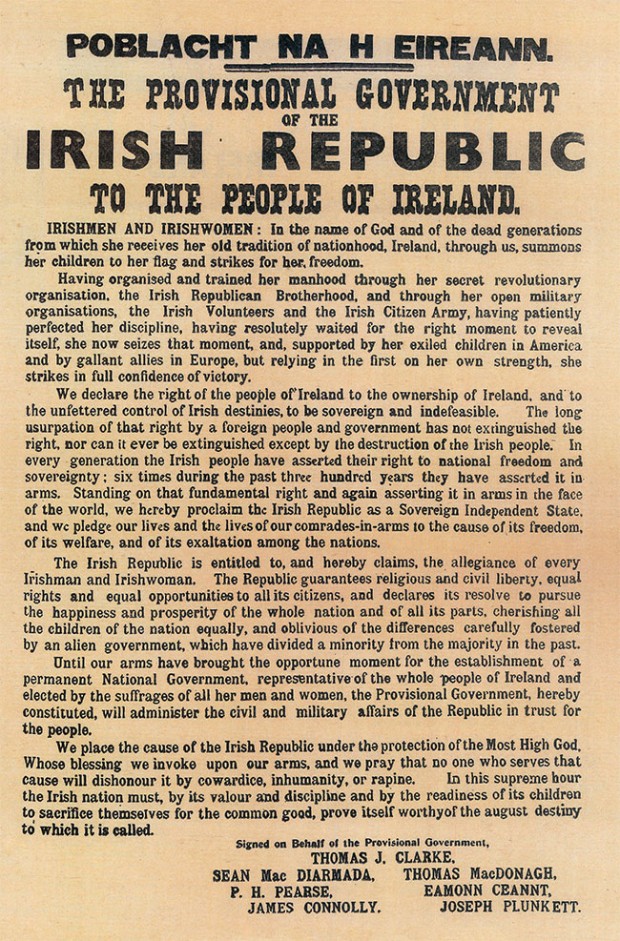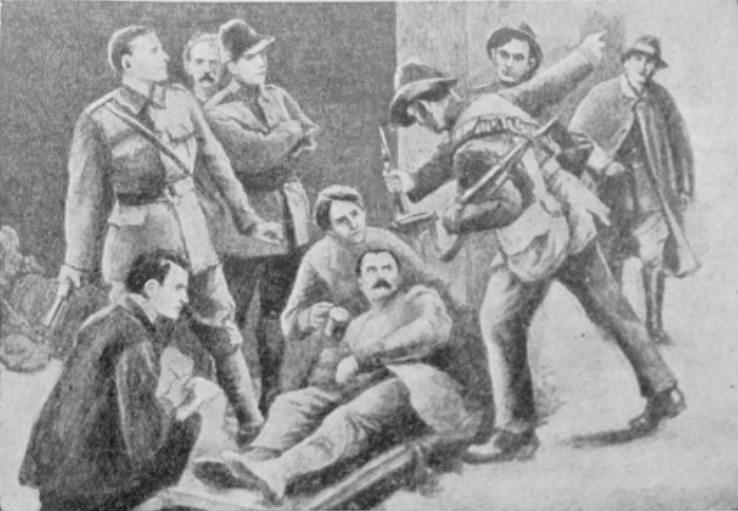More languages
More actions
| Easter Rising | |||||||
|---|---|---|---|---|---|---|---|
| Part of British Imperialism in Ireland | |||||||
    From top to bottom, right to left: Irish Republicans hold their positions in wait behind a barricade • The General Post Office in the aftermath of the Easter Rising • The Proclamation of the Irish Republic, which was read at the beggining of the Rising • A Soviet portrayal of the events inside the GPO | |||||||
| |||||||
| Belligerents | |||||||
|
Irish Republicans Irish Volunteers Irish Citizen Army Irish Republican Brotherhood Cumann na mBan Fianna Éireann Hibernian Rifles |
United Kingdom of Great Britain and Northern Ireland Royal Ulster Constabulary British Army | ||||||
The Easter Rising[a] was a rebellion against British rule in Ireland in 1916. The rising was started on April 24, 1916 in Dublin by Irish Republicans including Irish Socialist James Connolly.[1] The groups involved with the rising include the Irish Volunteers, the Irish Republican Brotherhood, the Irish Citizens Army, and Cumann na mBan. After 6 days of fighting the rebels surrendered. In the months following the British executed most leaders of the rising, and imprisoned thousands of participants in prison camps including Frongoch camp in Wales.[2]
Groups Involved[edit | edit source]
Irish Volunteers[edit | edit source]
The Irish volunteers were an Irish Republican organization founded in 1913 to oppose Protestant paramilitaries and support Irish national liberation.[3]
Irish Citizens Army[edit | edit source]
A Socialist republican group founded during the 1913 Dublin Lockout by James Connolly and others.[3]
Cumann na mBan[edit | edit source]
A women's group founded in 1914 whose members included Constance Markievicz and other Socialist Republicans.[3]
Irish Republican Brotherhood[edit | edit source]
A Irish Republican secret society founded in 1858 by former members of the Young Ireland movement. It pioneered the strategy of bombings of infrastructure, military, and political targets.[4]
Leaders[edit | edit source]
James Connolly[edit | edit source]
James Connolly was an Irish Socialist and Trade Unionist who founded the Irish Citizens army and was involved in the 1913 Dublin Lockout as well as the Easter Rising. He was one of the seven signatories of the Proclamation of the Irish Republic and was executed in the aftermath.[5]
Patrick Pearse[edit | edit source]
Sometimes referred to by the Irish language names Padraig or Padraic. He was a schoolteacher in Dublin and a longtime supporter of Irish Nationalism and Republicanism. He was also a poet, with is most famous poem Óró sé do bheatha abhaile becoming a well known Irish Republican anthem during his life and after his death. He was another signatory of the proclamation, and is considered to have been the most prominent leader of the rising. He was also executed in the aftermath.[6]
Constance Markievicz[edit | edit source]
She was a leading member of both Cumann na mBan and the Irish Citizens Army and founded the youth group Fianna Eireann. Despite coming from a prominent and wealthy Anglo-Irish (English families who had lived in Ireland for several generations), Markievicz was a Socialist and Feminist in addition to being an Irish Republican. After the Rising, was elected to the British parliament in 1918, becoming the first woman ever elected to parliament in Britain. However, as an Irish Republican, she did not take her seat in Westminster and instead formed the First Dail with other Irish Republicans, leading to the Irish Revolution.[7]
Thomas Clarke[edit | edit source]
Tom Clarke was involved in many Irish Republican actions during his life, including involvement with Clan na Gael, which he joined in 1882. He spent many years in prison. He played a role in the revitalization of the Irish Republican Brotherhood and planned the Easter Rising. He signed the Proclamation of the Irish Republic. On May 3 1916 he was executed for his role in the rising.[8]
Other Figures[edit | edit source]
Roger Casement[edit | edit source]
Roger Casement was a diplomat for the United Kingdom and a was even knighted before his involvement in the Easter Rising. In 1884 he traveled to the Congo, then subject to the genocidal colonization by Leopold II of the Kingdom of Belgium. There he saw the horrors of imperialism and began to fight against it, first publishing the Casement Report, eventually leading to the end of Leopolds rule of the Congo. Later he exposed the abuses against the natives of the Putumayo region of the Amazon. He was knighted and became a respected figure in Britain. He sought weapons from German Empire, Britain's enemy in the first world war, to help the Easter Rising and eventually returned to Ireland on a German U-Boat with weapons. There he was caught and put in prison. Due to his reputation in Britain at the time his personal diaries, detailing his homosexual relationships, were released in order to slander him in the eyes of the generally Homophobic British public. At the trial he was found guilty of violating the Treason Act of 1351 after it was decided that the act included acts commited outside of the UK. This descision was controversial, as it assumed a comma was intended to be placed in the text. Casement remarked that he was being "hanged on a comma." He was executed on August 3, 1916.[9] [10][11]
Margaret Skinnider[edit | edit source]
Margaret Skinnider was born in county Monaghan in 1893. She was a teacher before the Easter Rising and a staunch Irish Republican, Feminist, and Socialist. She smuggled explosives and mapped out a barrack at the request of Constance Marckievicz and joined the Irish Citizens Army. During the Easter Rising she played a significant role in combat, both as a sniper and as the leader of a small team sent to stop a the retreat of a British force. She was the only woman seriously injured during the rising, having been shot 3 times. She participated in a propoganfa your for Cumann na mBan, played a role in the Irish Revolution and civil war and became a leading trade unionist. She lived for most of her life with fellow revolutionary Nora O'Keefe and it is likely she was one of several LBGT+ participants in the Easter Rising.[12][13]
Notes[edit | edit source]
- ↑ Irish: Éirí Amach na Cásca
References[edit | edit source]
- ↑ Francis X. Martin (2019). Leaders and Men of the Easter Rising: Dublin 1916 (p. 105).
- ↑ Maev Kennedy (2015, December 27). "Welsh village summons ghosts of Ireland's revolutionary past" The Guardian.
- ↑ 3.0 3.1 3.2 "ORGANISATIONS LINKED TO THE EASTER RISING". 1916 Rebellion Walking Tour.
- ↑ "The Irish Republican Brotherhood (IRB)". BBC.
- ↑ "James Connolly". Marxists Internet Archive.
- ↑ "Easter Rising Profiles Patrick Pearse". BBC.
- ↑ "Constance Markievicz". Women's Museum of Ireland.
- ↑ "Tom Clarke, member of the Provisional Government of the Irish Republic". National Library of Ireland.
- ↑ Kevin Grant (2016-9-28). "Roger Casement: Gay Irish Martyr or Victim of British Forgery?" The Guardian.
- ↑ Sorcha Pollak (2016-7-30). "Why Roger Casement is still remembered by the people of the Amazon" The Irish Times.
- ↑ Patrick Macrory (2019-6-27). "The Man Hanged Because of a Comma" The Guardian.
- ↑ "Margaret Skinnider". Women's Museum of Ireland.
- ↑ Mary Mcauliffe (2020-3-16). "Margaret Skinnider: radical feminist, militant nationalist, trade union activist" Irish Times.
